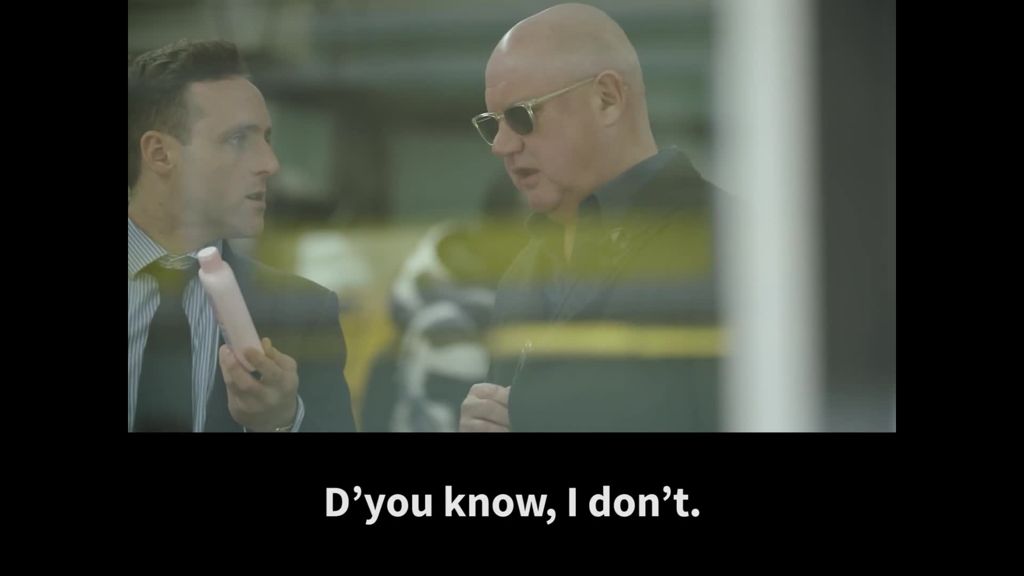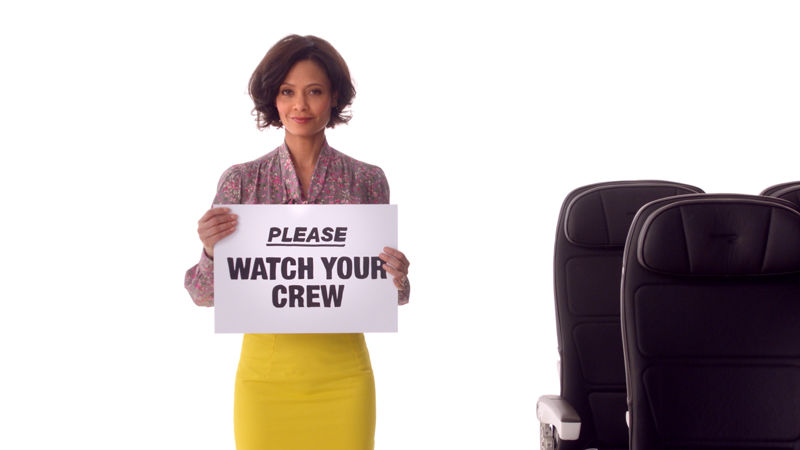Don’t bulls**t purpose, make us laugh
Two time Comedy BAFTA nominee and one time winner (for The Revolution Will Be Televised), and the co-founder of Don’t Panic, Joe Wade, gives us his opinion of why comedy sells.
It's been bad times for comedians... Kevin Hart couldn't even sip from Oscar's poisoned chalice before his homophobic tweets were unearthed and he, rightfully, had to resign the dubious honour.
Onanism aside, Louis CK got into deep water with an attempted joke about Parkland School massacre survivors before compounding his offensiveness with some gags about transgender pronouns; in fact, even the unlikeliest of candidates have found themselves on the wrong side of trans issues, with Father Ted and IT Crowd creator Graham Linehan being picketed and cautioned by police due to some of his Tweets.
On one level comedy is simply a sideways look at the world; from sophisticated satire to the sort of observational ‘why-does-one-sock-always-go-AWOL’ Michael McIntyre school of laughs. However the best comedy is more like philosophy, presenting new ways of looking at the world that don’t just reflect and respond to society but move discourse forward and conceive cultural touch points; from playground friendly catch phrases like 'computer says no', to indelible characters like Alan Partridge.
As Louis CK (arguably the best stand-up of his generation) has illustrated, the best comedy requires treading a fine line between provocation and outrage. The real challenge is the line is always moving as society’s standards change. Well into the 90s, comedians like Jim Davidson, who was infamous for telling racist, sexist and homophobic jokes, were still presenting primetime shows on the BBC, now he can barely sell Clacton pier. The line is continuously moving and you have to move with it. Despite being the least of his misdemeanors, CK’s jokes about trans people are out of step with the times and will ultimately lead to his terminal irrelevance.
We live in depressing times and a brand that brings laughs and levity into people’s lives will earn a lot of genuine love.
It's into this febrile and precarious environment for humour, that I'm going to suggest bringing back funny, risky and relevant advertising. The experience will be like being one of the those Nepalese honey hunters, scaling a perilous rock face, in search of sweet reward, except you’ll have a client strapped to your back who won't stop wriggling and saying they're scared of heights. The discomfort and risks are worth the reward; here are some top tips to help you avoid plummeting to your doom.
Why be funny?
We all know that terrestrial TV advertising is irrelevant for young audiences (unless Love Island’s on) as they all watch Netflix; we also know this challenges us as advertisers to connect digitally as clicking away, skipping and blocking are all too easy. With videos projected to make up 82% of all consumer internet traffic by 2021 (Cisco, 2019), funny advertising is a surefire way to entice and capture this audience in a cluttered environment.
According to a recent Harris Poll, today, 55% of millennials insist on laughter before sharing any content.
Purpose-led advertising has at least as many pitfalls as humour, as the audience is super smart and they sense inauthenticity. If purpose is being used to increase brand relevance, as Gillette seemed to attempt to do with their abomination We Believe: The Best Men Can Be, then we can use humour to do the same thing. By all means let’s add a layer of cultural relevance to ads but let’s do it in a tongue-in-cheek way that demonstrates that we understand the zeitgeist, but want to avoid lecturing consumers.
Credits
powered by
- Agency Don't Panic/London
- Production Company In-House at Agency
- Director Directed by Agency
-
-
Unlock full credits and more with a Source + shots membership.
Credits
powered by
- Agency Don't Panic/London
- Production Company In-House at Agency
- Director Directed by Agency

Credits
powered by
- Agency Don't Panic/London
- Production Company In-House at Agency
- Director Directed by Agency
We live in depressing times and a brand that brings laughs and levity into people’s lives will earn a lot of genuine love - a classic value exchange, whereby the audience will reward a LOL with a like, share or purchase. According to a recent Harris Poll, today, 55% of millennials insist on laughter before sharing any content.
This is even more true for non-profits, where comedy can reframe the narrative of serious issues. Our recent campaign for PETA did exactly this: we know that people can switch off with overly righteous messaging, so we dressed up a man as a baby to make drinking cow’s milk seem ridiculous.
Returning to walking the line between provocation and outrage, making provocative advertising that divides audiences is a wise strategy. Nike does it in a political way using Colin Kaepernick to voice its position on police brutality, but other brands have done it with divisive humour.
Mountain Dew’s #PuppyMonkeyBaby commercial might have switched off most consumers, but the bizarre concept landed with the young males they most wanted to reach; the idea achieved four times more mentions than any other hashtag during 2016’s Super Bowl. Paddy Power also follows a similar strategy, using highly PR-able ‘can-they-get-away-with-that?’ marketing stunts which get a laugh from their core audience, and horrifies others. In fact, it’s likely that the more you piss off the trolls, the funnier your ad is.
Don’t forget about characters. Some of the most enduring funny adverts have been based around an amusing character.
Credits
powered by
- Agency BBDO NY
- Production Company Smith & Jones
- Director Ulf Johansson
-
-
Unlock full credits and more with a Source + shots membership.
Credits
powered by
- Agency BBDO NY
- Production Company Smith & Jones
- Director Ulf Johansson
- Chief Cr Off No. Amer David Lubars
- Chief Cr Off Greg Hahn
- Exec CD Lauren Connolly
- CD/CW Don Marshall Wilhelmi
- CD/AD Monty Pera
- Group Exec Producer Julian Katz
- Exec Prod Matt Nowak
- Sr Producer Whitney Collins
- Exec Producer Camila De Biaggi
- Head of Production Jesse Kurnit
- Producer Elizabeth Hurd
- Producer Amy Richardson
- Audio Engineer Tom Jucarone
- Sound Designer Ren Klyce
- Producer Misa Kageyama
- Editor Paul Watts
- DP Dick Pope
- Executive Producer Philippa Smith
- Executive Producer Eve Kornblum
- Producer Lisa Barnable
- Asst Editor Sarah Igraine Welty
- VFX Supervisor Alex Lovejoy
- VFX Supervisor: Kamen Markov
- Colorist Jean-Clement Soret
- Colorist Adrian Seery
- 2D Lead Compositor Aleksandar Djordjevic
- 2D Team Sohee Sohn
- 2D Team Christopher Russo
- Production Manager Polly Leach
- Production Coordinator Matt Bulaitis
- Asst Editor Maria Lee
- Asst Editor Jim Robinson

Credits
powered by
- Agency BBDO NY
- Production Company Smith & Jones
- Director Ulf Johansson
- Chief Cr Off No. Amer David Lubars
- Chief Cr Off Greg Hahn
- Exec CD Lauren Connolly
- CD/CW Don Marshall Wilhelmi
- CD/AD Monty Pera
- Group Exec Producer Julian Katz
- Exec Prod Matt Nowak
- Sr Producer Whitney Collins
- Exec Producer Camila De Biaggi
- Head of Production Jesse Kurnit
- Producer Elizabeth Hurd
- Producer Amy Richardson
- Audio Engineer Tom Jucarone
- Sound Designer Ren Klyce
- Producer Misa Kageyama
- Editor Paul Watts
- DP Dick Pope
- Executive Producer Philippa Smith
- Executive Producer Eve Kornblum
- Producer Lisa Barnable
- Asst Editor Sarah Igraine Welty
- VFX Supervisor Alex Lovejoy
- VFX Supervisor: Kamen Markov
- Colorist Jean-Clement Soret
- Colorist Adrian Seery
- 2D Lead Compositor Aleksandar Djordjevic
- 2D Team Sohee Sohn
- 2D Team Christopher Russo
- Production Manager Polly Leach
- Production Coordinator Matt Bulaitis
- Asst Editor Maria Lee
- Asst Editor Jim Robinson
The dos and don’t of LOLs
Despite the famous EB White quote that 'explaining a joke is like dissecting a frog. You understand it better but the frog dies in the process'. I’m going to do just that.
Do: Always aim up! Meaning the subject of satire and mockery needs to be the powers that be and the majority. Never aim at vulnerable groups or minorities.
Do: Employ professional comedy writers. They can be decent value and will understand how to construct a sketch-like ad better than an advertising copywriter.
Do: Ensure relevance of the ad to both your brand and product but to the general zeitgeist too. Employ a writer’s room approach - like the perfect dinner party or gathering, you want bunch of different opinions in there and yet you don’t want to get bogged down in conflict. Look for people who understand how to play well with others but who have strong personalities; people who are real shit-stirrers creatively, but well-behaved in real-life.
To remain relevant, advertising needs to be riskier to stand out.
Don’t: Play it safe. Humour needs to have an edge. One way to determine whether you’re getting this right is if all stakeholders are happy with your ad. If they are your ad will lack the element of risk that will make it really funny.
Don’t: Underestimate the intelligence of audiences. To be truly funny jokes must demand a leap of the imagination for the audience; the pause between hearing it and getting it. If it’s dumbed down there’s no space for people to get it.
Don’t: Forget about characters. Some of the most enduring funny adverts have been based around an amusing character that enables you to personify different propositions and attributes of your brand. Sometime the characters are so good no-one can remember what they’re advertising, like the meerkats, but that’s an ok problem to have.
Credits
powered by
- Agency VCCP
- Production Company Passion Pictures
-
-
-
Unlock full credits and more with a Source + shots membership.
Credits
powered by
- Agency VCCP
- Production Company Passion Pictures
- Sound Design Clearcut Sound Studios
- Grade Rushes
- Post Production Rushes
- Editor Gus Herdman
- Agency Producer Larissa Miola
- Executive Creative Director Darren Bailes
- Executive Producer Russell McLean
- Creative Matt Hynds
- Creative Liam Wilson
- Director Darren Walsh
- Producer Anna Cunnington
- Creative Director Matt Lloyd
- VFX Supervisor Neil Riley
- Colourist Denny Cooper
- Sound Designer James Clark

Credits
powered by
- Agency VCCP
- Production Company Passion Pictures
- Sound Design Clearcut Sound Studios
- Grade Rushes
- Post Production Rushes
- Editor Gus Herdman
- Agency Producer Larissa Miola
- Executive Creative Director Darren Bailes
- Executive Producer Russell McLean
- Creative Matt Hynds
- Creative Liam Wilson
- Director Darren Walsh
- Producer Anna Cunnington
- Creative Director Matt Lloyd
- VFX Supervisor Neil Riley
- Colourist Denny Cooper
- Sound Designer James Clark
To remain relevant, advertising needs to be riskier to stand out. More than ever ads need to adopt an editorial approach and offer audiences value in the form of entertainment, to keep them engaged. Humour is a very valid and workable alternative to rattling on about purpose the whole time, and even though comedy is a bit of a minefield at the moment it’s definitely one worth navigating. People recognise BS.
So, if you haven’t anything really true to say, at least have a laugh.
)




 + membership
+ membership










